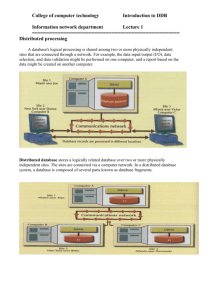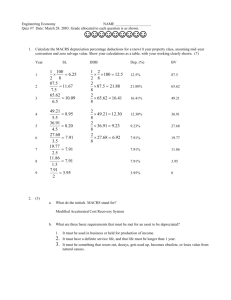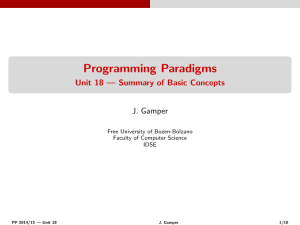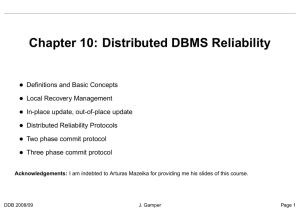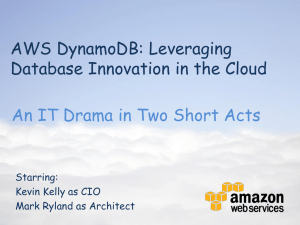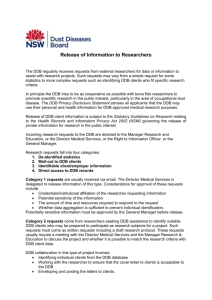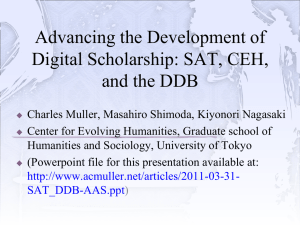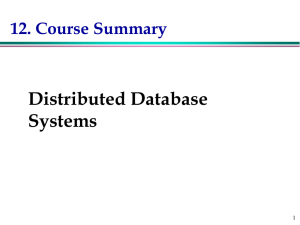Chapter 2: DDBMS Architecture
advertisement
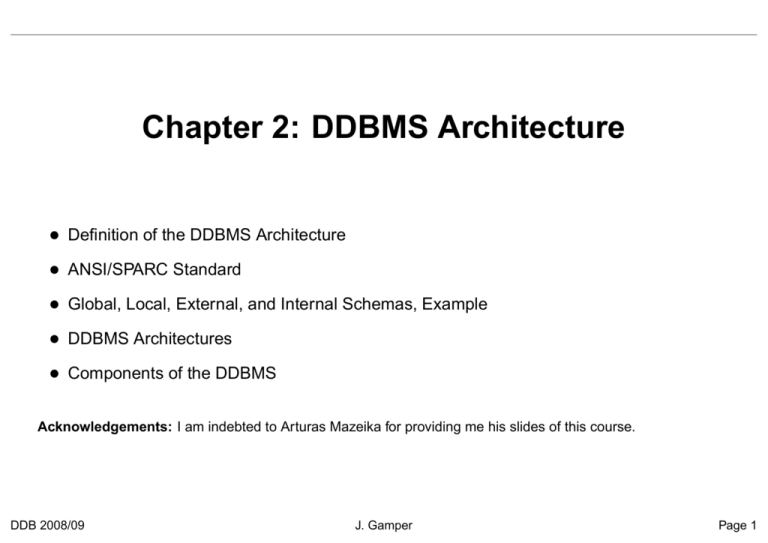
Chapter 2: DDBMS Architecture
• Definition of the DDBMS Architecture
• ANSI/SPARC Standard
• Global, Local, External, and Internal Schemas, Example
• DDBMS Architectures
• Components of the DDBMS
Acknowledgements: I am indebted to Arturas Mazeika for providing me his slides of this course.
DDB 2008/09
J. Gamper
Page 1
Definition
• Architecture: The architecture of a system defines its structure:
– the components of the system are identified;
– the function of each component is specified;
– the interrelationships and interactions among the components are defined.
• Applies both for computer systems as well as for software systems, e.g,
– division into modules, description of modules, etc.
– architecture of a computer
• There is a close relationship between the architecture of a system, standardisation
efforts, and a reference model.
DDB 2008/09
J. Gamper
Page 2
Motivation for Standardization of DDBMS Architecture
• DDBMS might be implemented as homogeneous or heterogeneous DDBMS
• Homogeneous DDBMS
– All sites use same DBMS product
– It is much easier to design and manage
– The approach provides incremental growth and allows increased performance
• Heterogeneous DDBMS
– Sites may run different DBMS products, with possibly different underlying data models
– This occurs when sites have implemented their own databases first, and integration is
considered later
– Translations are required to allow for different hardware and/or different DBMS
products
– Typical solution is to use gateways
⇒ A common standard to implement DDBMS is needed!
DDB 2008/09
J. Gamper
Page 3
Standardization
• The standardization efforts in databases developed reference models of DBMS.
• Reference Model: A conceptual framework whose purpose is to divide standardization
work into manageable pieces and to show at a general level how these pieces are
related to each other.
• A reference model can be thought of as an idealized architectural model of the system.
• Commercial systems might deviate from reference model, still they are useful for the
standardization process
• A reference model can be described according to 3 different approaches:
– component-based
– function-based
– data-based
DDB 2008/09
J. Gamper
Page 4
Standardization . . .
• Components-based
– Components of the system are defined together with the interrelationships between
the components
– Good for design and implementation of the system
– It might be difficult to determine the functionality of the system from its components
DDB 2008/09
J. Gamper
Page 5
Standardization . . .
• Function-based
– Classes of users are identified together with the functionality that the system will
provide for each class
– Typically a hierarchical system with clearly defined interfaces between different layers
– The objectives of the system are clearly identified.
– Not clear how to achieve the objectives
– Example: ISO/OSI architecture of computer networks
DDB 2008/09
J. Gamper
Page 6
Standardization . . .
• Data-based
– Identify the different types of the data and specify the functional units that will realize
and/or use data according to these views
– Gives central importance to data (which is also the central resource of any DBMS)
→ Claimed to be the preferable choice for standardization of DBMS
– The full architecture of the system is not clear without the description of functional
modules.
– Example: ANSI/SPARC architecture of DBMS
DDB 2008/09
J. Gamper
Page 7
Standardization . . .
• The interplay among the 3 approaches is important:
– Need to be used together to define an architectural model
– Each brings a different point of view and serves to focus on different aspects of the
model
DDB 2008/09
J. Gamper
Page 8
ANSI/SPARC Architecture of DBMS
• ANSI/SPARC architecture is based on data
• 3 views of data: external view, conceptual view, internal view
• Defines a total of 43 interfaces between these views
DDB 2008/09
J. Gamper
Page 9
Example
• Conceptual schema: Provides enterprise view of entire database
RELATION EMP [
KEY = {ENO}
ATTRIBUTES = {
ENO : CHARACTER(9)
ENAME: CHARACTER(15)
TITLE: CHARACTER(10)
}
RELATION PROJ [
KEY = {PNO}
ATTRIBUTES = {
PNO
: CHARACTER(7)
PNAME : CHARACTER(20)
BUDGET: NUMERIC(7)
LOC
: CHARACTER(15)
}
]
]
RELATION PAY [
KEY = {TITLE}
ATTRIBUTES = {
TITLE: CHARACTER(10)
SAL : NUMERIC(6)
}
]
RELATION ASG [
KEY = {ENO,PNO}
ATTRIBUTES = {
ENO : CHARACTER(9)
PNO : CHARACTER(7)
RESP: CHARACTER(10)
DUR : NUMERIC(3)
}
]
DDB 2008/09
J. Gamper
Page 10
Example . . .
• Internal schema: Describes the storage details of the relations.
– Relation EMP is stored on an indexed file
– Index is defined on the key attribute ENO and is called EMINX
– A HEADER field is used that might contain flags (delete, update, etc.)
Conceptual schema:
INTERNAL REL EMPL [
INDEX ON E# CALL EMINX
FIELD =
HEADER: BYTE(1)
E#
: BYTE(9)
ENAME : BYTE(15)
TIT
: BYTE(10)
RELATION EMP [
KEY = {ENO}
ATTRIBUTES = {
ENO : CHARACTER(9)
ENAME: CHARACTER(15)
TITLE: CHARACTER(10)
}
]
]
DDB 2008/09
J. Gamper
Page 11
Example . . .
• External view: Specifies the view of different users/applications
– Application 1: Calculates the payroll payments for engineers
CREATE VIEW PAYROLL (ENO, ENAME, SAL) AS
SELECT EMP.ENO,EMP.ENAME,PAY.SAL
FROM
EMP, PAY
WHERE EMP.TITLE = PAY.TITLE
– Application 2: Produces a report on the budget of each project
CREATE VIEW BUDGET(PNAME,
SELECT PNAME, BUDGET
FROM PROJ
DDB 2008/09
J. Gamper
BUD) AS
Page 12
Architectural Models for DDBMSs
• Architectural Models for DDBMSs (or more generally for multiple DBMSs) can be
classified along three dimensions:
– Autonomy
– Distribution
– Heterogeneity
DDB 2008/09
J. Gamper
Page 13
Architectural Models for DDBMSs . . .
• Autonomy: Refers to the distribution of control (not of data) and indicates the degree to
which individual DBMSs can operate independently.
– Tight integration: a single-image of the entire database is available to any user who
wants to share the information (which may reside in multiple DBs); realized such that
one data manager is in control of the processing of each user request.
– Semiautonomous systems: individual DBMSs can operate independently, but have
decided to participate in a federation to make some of their local data sharable.
– Total isolation: the individual systems are stand-alone DBMSs, which know neither of
the existence of other DBMSs nor how to comunicate with them; there is no global
control.
• Autonomy has different dimensions
– Design autonomy : each individual DBMS is free to use the data models and
transaction management techniques that it prefers.
– Communication autonomy : each individual DBMS is free to decide what information
to provide to the other DBMSs
– Execution autonomy : each individual DBMS can execture the transactions that are
submitted to it in any way that it wants to.
DDB 2008/09
J. Gamper
Page 14
Architectural Models for DDBMSs . . .
• Distribution: Refers to the physical distribution of data over multiple sites.
– No distribution: No distribution of data at all
– Client/Server distribution:
∗ Data are concentrated on the server, while clients provide application
environment/user interface
∗ First attempt to distribution
– Peer-to-peer distribution (also called full distribution):
∗ No distinction between client and server machine
∗ Each machine has full DBMS functionality
DDB 2008/09
J. Gamper
Page 15
Architectural Models for DDBMSs . . .
• Heterogeneity: Refers to heterogeneity of the components at various levels
– hardware
– communications
– operating system
– DB components (e.g., data model, query language, transaction management
algorithms)
DDB 2008/09
J. Gamper
Page 16
Architectural Models for DDBMSs . . .
DDB 2008/09
J. Gamper
Page 17
Client-Server Architecture for DDBMS (Data-based)
• General idea: Divide the functionality into two
classes:
– server functions
∗ mainly data management, including
query processing, optimization, transaction management, etc.
– client functions
∗ might also include some data management functions (consistency checking,
transaction management, etc.) not just
user interface
• Provides a two-level architecture
• More efficient division of work
• Different types of client/server architecture
– Multiple client/single server
– Multiple client/multiple server
DDB 2008/09
J. Gamper
Page 18
Peer-to-Peer Architecture for DDBMS (Data-based)
• Local internal schema (LIS)
– Describes the local physical data organization (which might be different
on each machine)
• Local conceptual schema (LCS)
– Describes logical data organization
at each site
– Required since the data are fragmented and replicated
• Global conceptual schema (GCS)
– Describes the global logical view of
the data
– Union of the LCSs
• External schema (ES)
– Describes the user/application view
on the data
DDB 2008/09
J. Gamper
Page 19
Multi-DBMS Architecture (Data-based)
• Fundamental difference to peer-to-peer DBMS is in the definition of the global
conceptual schema (GCS)
– In a MDBMS the GCS represents only the collection of some of the local databases
that each local DBMS want to share.
• This leads to the question, whether the GCS should even exist in a MDBMS?
• Two different architecutre models:
– Models with a GCS
– Models without GCS
DDB 2008/09
J. Gamper
Page 20
Multi-DBMS Architecture (Data-based) . . .
• Model with a GCS
– GCS is the union of parts of the LCSs
– Local DBMS define their own views on the local DB
DDB 2008/09
J. Gamper
Page 21
Multi-DBMS Architecture (Data-based) . . .
• Model without a GCS
– The local DBMSs present to the multi-database layer the part of their local DB they
are willing to share.
– External views are defined on top of LCSs
DDB 2008/09
J. Gamper
Page 22
Regular DBMS (Component-based)
DDB 2008/09
J. Gamper
Page 23
General DDBMS (Component-based)
DDB 2008/09
J. Gamper
Page 24
Client-Server Architecture (Component-based)
• One server, many clients
DDB 2008/09
J. Gamper
Page 25
Components of Client-Server Architecture (Component-based)
• Many servers, many clients
DDB 2008/09
J. Gamper
Page 26
Components of Client-Server Architecture (Component-based) . . .
• Many servers, many clients
DDB 2008/09
J. Gamper
Page 27
Components of Peer-to-Peer Architecture (Component-based)
DDB 2008/09
J. Gamper
Page 28
Components of Multi-DBMS Architecture (Component-based)
DDB 2008/09
J. Gamper
Page 29
Conclusion
• Architecture defines the structure of the system. There are three ways to define the
architecture: based on components, functions, or data
• DDBMS might be based on identical components (homogeneous systems) or different
components (heterogeneous systems)
• ANSI/SPARC architecture defines external, conceptual, and internal schemas
• There are three orthogonal implementation dimensions for DDBMS: level of distribution,
autonomity, and heterogeinity
• Different architectures are discussed:
– Client-Server Systems
– Peer-to-Peer Systems
– Multi-DBMS
DDB 2008/09
J. Gamper
Page 30
